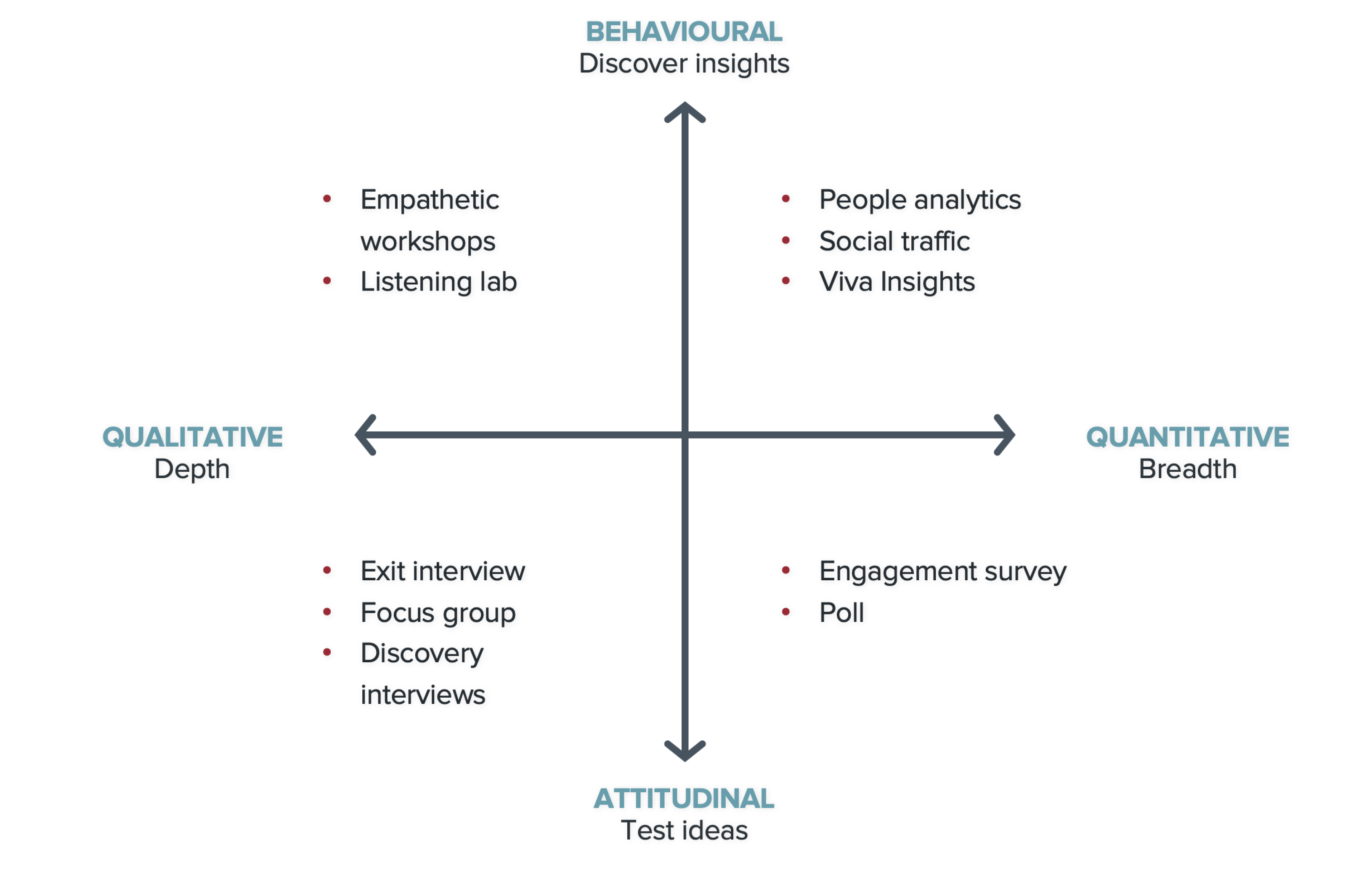Employee listening isn’t just a tool to help you measure engagement; it’s a capability that has the power to drive the evolution of your employee experience, culture and organizational strategy.
Great employee listening is deliberate, thoughtful and genuine. It should bring clear evidence and help you:
- Design your organizational strategy by providing insight into the opportunities and limitations imposed by your people and culture.
- Inform how you deliver on your business model by connecting the needs of your business to the output of your people.
- Open up dialogue by creating a focal point for conversation with your whole organization about the health of your workplace.
The more you understand about what’s going on in the hearts and minds of employees and how it impacts the real work that they do, the more power you have to impact your organization’s overall performance.
Employee listening is a capability in the organization that enables confident decisions about building an intentional culture.
For healthy, effective employee listening, you’ll need more than an annual employee survey. In this post, we’ll show you how to develop dynamic, responsive listening capabilities, and share an example of how Habanero's listening capabilities drive positive change in our organization.
Craft your employee listening portfolio
Fundamentally, employee listening is ethnographic research. We think of it as a portfolio of different research methods, each with its own merits.
At the core of your listening capabilities is the ability to understand how to choose the right method for each situation. If you lean on just one research method, you’ll limit what you can hear, learn and act on. But with a portfolio, you can take a step back and consider what you need to know before choosing the most effective research method for your needs. There are times when you might want to dig into an issue to get the full story; in other instances, you might want to zoom out to see bigger trends. Each serves a different purpose; together, they create a dynamic and holistic body of insights.
We designed this visual to help organizations map research methods to different scenarios, so it’s easier to know what method to use when. Each research method is mapped to a quadrant, based on whether it uses either attitudinal (things we can ask people about) or behavioural (things we observe) methods and generates either quantitative or qualitative data.
Let’s break the quadrants down to better understand these categories:
- Quantitative behavioural capabilities measure what’s going on in your organization. Sources of quantitative behavioural insights include traffic on your intranet and social channels, crowdsourcing, and technology like Viva Insights, which captures interactions across Microsoft 365. Using these observational insights, we can try to draw conclusions about employees’ behaviours, such as how they work.
- Quantitative attitudinal capabilities give you a broad understanding about what’s going on in your organization quickly and efficiently. They’re great for monitoring performance and identifying trends. Engagement surveys and polls belong in this category, because they focus on testing, not discovery.
- Qualitative attitudinal capabilities involve going deeper into an idea to understand the story in order to test your ideas. They include focus groups, discovery interviews and open-ended exit interviews. In focus groups, participants are asked a series of questions that allow them to share their opinions while discovery interviews zoom in on a person’s experience to understand it at a deeper level.
- Qualitative behavioural capabilities offer the richest view of what’s happening in an organization. It's also the set of capabilities that organizations need to strengthen the most. Empathetic research workshops and interviews as well as listening labs belong in this quadrant. To do these well, you need to create a mental model that gives people the opportunity to talk through their world. The focus is on their personal experiences and feelings rather than their expertise or opinions. A skilled researcher can pull themes from these observational sessions and use them to understand what's going on in people’s hearts and minds.
Employee listening: A Habanero example
About a year into the pandemic, talk of burnout started showing up everywhere – in the press, in conversations with our clients and internally at Habanero. While we weren't seeing it in our employee survey, we had some anecdotal evidence that it might be becoming an issue with our employees. To understand how people were truly feeling, we designed an empathetic research study.
We learned that people were working long hours and their days were full of meetings with very little time in between. As a result, they were exhausted, and they were feeling symptoms of malaise and burnout. Very quickly, we were able to make some changes. We capped half-hour meetings to 25 minutes and one-hour meetings were now 50 minutes. These changes gave people some breathing room, which was helpful, but they also needed time and space to do deep work. We learned that people lacked time and space for focused work using a qualitative attitudinal method, but it took a qualitative observational method to uncover the impact it was having on people. The findings are distinct but intimately related. Together, these research methods helped us identify the lack of time and space for deep work as the more important issue.
To address this need, together we designed a rest and flow Friday system. Every second Friday, a group of employees took the day off to do something to nourish themselves. On alternate Fridays, they worked but had no meetings. The impact was immediately positive. Employees looked forward to the Flow Fridays, knowing they could dive in and do the focused work that was so energizing for them.
Since we first implemented this new rhythm, we’ve continued to fine tune it. This solution worked for us because it originated from our research. We didn’t try to adopt the system from another organization or adapt something we read in an article. We designed a custom solution that directly fit our unique context, because we had the right research method to help us understand the employee experience with the appropriate fidelity.
As this example demonstrates, what people say doesn’t always match up with what they do. Great research seeks to understand both, and that’s the value of the portfolio. If we had relied on our employee survey alone, we wouldn’t have believed we even had a problem to solve. It was qualitative research that got us to the heart of the problem right away, and a behavioural method that allowed us to dig past how people were seeing their world to uncover the patterns underlying the deep work issue. The solution we designed based on these insights was right on the mark with the first iteration. We solved a tough problem quickly and cut out a lot of trial and error along the way.
Elevating employee listening
Employee listening has the potential to build amazing organizations when it’s approached as a strategic capability that you develop by actively listening to employees, including them in deeper level conversations, and being aware of which listening method(s) to use when. This combination of empathy with action can make a difference in your organization and become a source of positive change.
For more insights on employee listening, check out our recorded webinar: An employee listening strategy that truly listens. Also, feel free to reach out! We’d love to chat more.





.jpeg?bc=white&la=en&mw=416&modified=20251202191043&hash=E64AA9DFFAE8D1AC27890831F714D5B0FA2FEBB2)

